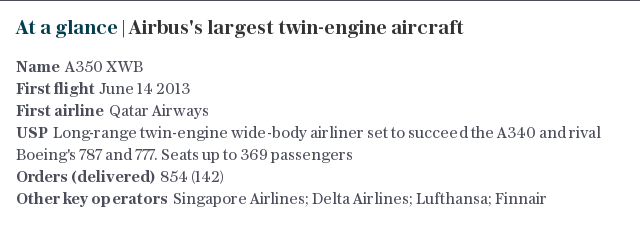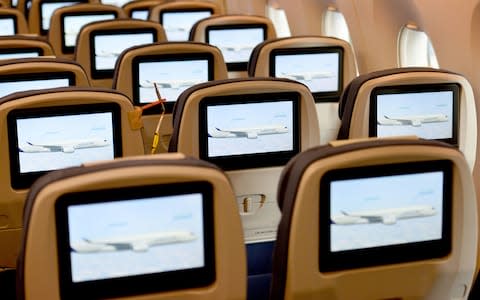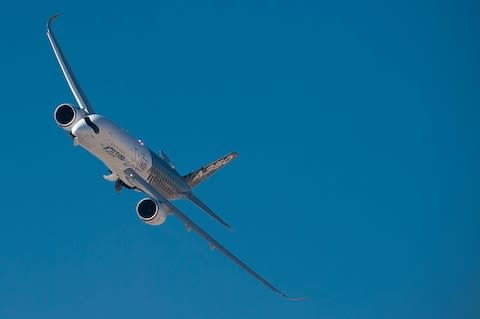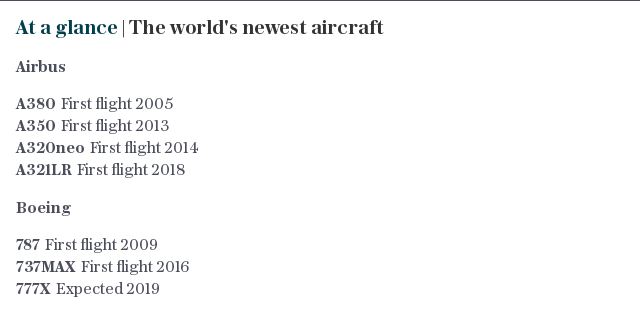Meet the man who flies on brand new aircraft before anyone else

“Good morning from the flight deck to the few passengers on board this brand new Airbus A350 XWB, shortly due to land in Mauritius,” said the captain. “After 12 hours of flying, I’m told by the prime minister that he is ready to witness our low-altitude fly-by and landing, so we’ll initiate our descent shortly. Thank you for being a significant part of the history of Mauritius. Please prepare for landing.”
The captain made his announcement as we gently descended over clear waters, after a very long night delivery flight from Airbus headquarters in Toulouse. Unlike in routine airline messages, I wasn’t thanked for “choosing” to fly with the airline, nor could I have “booked” this flight in the first place – as ultimately, this wasn’t a normal flight. It was a delivery.
I’m an aviation analyst, and in addition to broadcasting the aviation news on networks including the BBC, Sky, LBC and Al Jazeera, I work closely with aircraft manufacturers throughout the test flight and delivery of new jets for various airlines.
It’s an unusual field to be in I suppose, but it grew out of my love of aviation as a teenager. I studied at the sixth-form campus in Cambridge while reporting on aviation news, appearing first on Sky News when I turned 16. Now, almost six years later, I discuss aviation on 15 major networks.
A post shared by Alex Macheras (@alexlhr) on Oct 20, 2017 at 6:12am PDT
It’s not a job I applied for. It’s simply something that has evolved to become my career after being passionate about aviation for as long as I can remember. I followed and reported aviation news independently for many years before signing contracts with news networks.
A post shared by Alex Macheras (@alexlhr) on Dec 13, 2017 at 8:37am PST
So what does the job entail? The arrival of new jets is a milestone for any airline so launches are often grand, festive affairs featuring the finest champagne and the most VIP of guests, including airline CEOs, ambassadors, sheikhs and princes. At such events, a frisson of excitement is palpable in the air.

The home of new jets is often in desirable hubs such as Qatar, Singapore, Thailand, Hong Kong and Mauritius. On other occasions, the glamour can be a little more diluted – for example, when we delivered the first A320neo aircraft to easyJet’s home in Luton, Bedfordshire. It wasn’t quite the same feeling as I’ve had on a delivery descending among the Northern Lights over Finland, but it was just as big a milestone for easyJet as it is for other airline industry heavyweights.

“The thing about being involved in aircraft deliveries is that the world is very small for us,” a French A350 manager told me a while back, while we waited for our visa approval to enter Rwanda. A group of Rwandan dancers performed around the aircraft while we stood by the staircase, soon to be joined by the president and other government officials.

“In this line of work, we can often be on six of the seven continents of the world in just one week,” the manager told me as we smiled for another photograph. (Aircraft orders from the seventh, Antarctica, haven’t quite taken off yet.) Locals asked me what it was like to fly in the cabin. An elderly lady cried. “This new plane marks the beginning of a bright future for us in Rwanda,” she said. I hugged her.
Before the delivery, the aircraft will typically fly four test flights. This seems like a relatively small number, but it is often more than enough. Each plane is assembled at a factory and makes its way through production until it is ready to be delivered to the airline customer. Because Airbus has the “final assembly” process down to a tee, each plane that comes off the conveyor belt-style production line is an exact replica of the last one.

On a test flight, the aircraft is pushed to its limits, testing everything from how much stress and turbulence the cabin can withstand without anything becoming loose or separated, to how the aircraft reacts when the nose is pitched down at a high altitude and it heads towards “zero g” on the g-force scale.
For me, there’s no better way I could imagine spending a Wednesday afternoon than feeling sick, weightless and watching the super A350 wings curve and shake as we enter a controlled nose-dive towards the Dordogne. From such flights, I’ve experienced severe turbulence, with the aircraft shaking so intensely that I struggled to see. While I’m not worried about the safety aspects, as I know how safe and secure these aircraft are, it’s not something I go into too much detail about when my mother calls me to ask, “How was your day?”.
During these test flights, I have a number of responsibilities on board. First, during the cabin checks, I inspect exactly how the cabin was installed and specifically look for any defects or faults which may be evident in the different cabin products. As this is a new plane – meaning no passengers have had the chance to “normalise” it yet – everything should be perfect – but sometimes it isn’t.

“We’re not happy with the sound of this overhead locker when it opens,” a cabin engineer once told me. I listened as it unlatched and just about made out a quiet scratching sound. “This needs to be fixed before delivery – and it will be,” the engineer said, marking the locker with an X and entering the defect into the system.
Such examples are always eye-opening. So the next time you’re struggling to find overhead locker space on your easyJet Airbus to Malaga, you’ll know that the cabin engineers tested each locker to ensure the sound of the opening was “as it should be” – a sound only people in this area of the industry can listen out for, and nothing a passenger will ever be able to hear.
On one of my favourite deliveries to Thailand, I flew with a fun and energetic Thai Airways team who assisted in the delivery of the aircraft. Upon take-off, we ditched our formal wear for comfortable clothes as is routine for us on deliveries, and made ourselves at home in an empty, brand new jet. One colleague decided she didn’t want Airbus delivery catering (which, of course was a five-star, four-course meal) and instead bought a chicken from the local Toulouse rotisserie.

I made my way into the galley to plate up her chicken and we sat in business class in a pitch-black cabin somewhere over the Middle East, filling the “new plane smell” air with the aroma of a Sunday roast. It was Sunday, after all. How could we not?
In Thailand, thousands of locals greeted us at the airport. They waved flags with images of the aircraft. There was a buzz in the air and the airport organised a water canon salute or “baptism”, a celebratory gesture in aviation, where two fire engines shoot water into the air, creating an arch for the plane to taxi through.

I spent a few days exploring Bangkok, riding in tuk-tuks and feasting on Thai food at some beautiful restaurants including Osha, before boarding a commercial flight back to Europe, ready to do it all over again for another airline.
Back in Mauritius, I wrote my review of the aircraft for an aviation publication as I marvelled at views of Le Morne – the basaltic monolith looming large over emerald green lagoons. Afterwards, I ventured out for a walk along the powder-white sands of Dinarobin Beach. The following week, I was off to Singapore. But for now, I thought to myself, I was quite happy to be where I was – even though I’m always looking forward to returning to 43,000ft.
Alex Macheras is an aviation analyst for the BBC, LBC, ITV and Al Jazeera.


